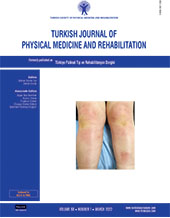Psychosocial problems and cognitive functions in children with spina bifida
2 Department of Physical Medicine and Rehabilitation, Pediatric Rehabilitation Unit, Marmara University School of Medicine, Istanbul, Turkey
3 Department of Child and Adolescent Psychiatry, Marmara University School of Medicine, Istanbul, Turkey
4 Department of Pediatrics, Division of Pediatric Nephrology, Marmara University School of Medicine, Istanbul, Turkey DOI : 10.5606/tftrd.2022.6658 Objectives: This study aims to assess psychosocial functioning in relation to lesion level and ambulatory status in children with spina bifida (SB) and compare them to their peers.
Patients and methods: Between March 2013 and May 2013, a total of 31 patients with SB (11 males, 20 females; mean age: 9.4 years; range, 6 to 14.7 years) and 36 typically developing peers (16 males, 20 females; mean age: 9.8 years; range, 6.5 to 14.8 years) were included in the study. All participants were assessed using a semi-structured psychiatric diagnostic interview via the Kiddie Schedule for Affective Disorders and Schizophrenia Present and Lifetime Version (K-SADS-PL), Wechsler Intelligence Scale for Children-Revised (WISC-R), Behavioral Rating Inventory of Executive Functions (BRIEF) parent form, Social Responsiveness Scale (SRS), and Aberrant Behavior Checklist (ABC).
Results: In the SB group, the rate of psychiatric disorders was significantly higher (p=0.001) and the SRS scores and the planning and organizational components of the executive function were higher than their peers (p=0.02 and p=0.007, respectively). The psychiatric diagnosis rate, BRIEF, and SRS total scores did not significantly differ according to lesion level and ambulatory status. The BRIEF initiate and organization of materials subtest scores and ABC scores were significantly lower at high lesion levels (p=0.02, p=0.02, and p=0.02, respectively) and non-community walkers (p=0.002, p=0.03, and p=0.003, respectively).
Conclusion: Psychiatric disorders, impairment in social responsiveness, and planning and organization components of the executive function are prevalent in children with SB with no intellectual disabilities, compared to their peers. Therefore, psychosocial counseling and multidisciplinary follow-up for SB patients seem to be beneficial.
Keywords : Children, cognitive impairment, psychiatric symptoms, psychosocial status, spina bifida

















